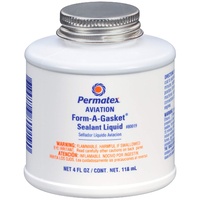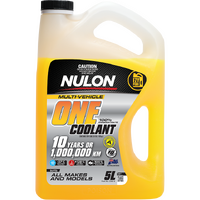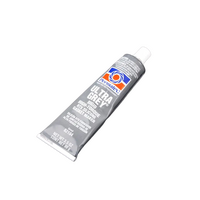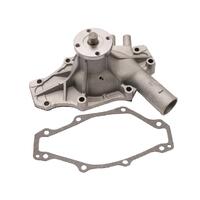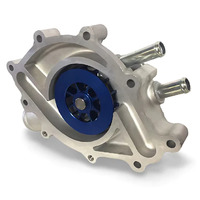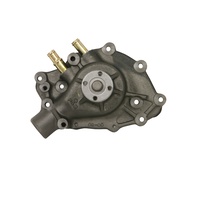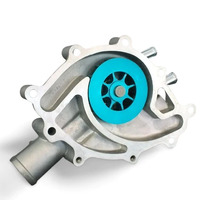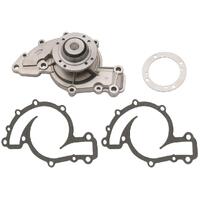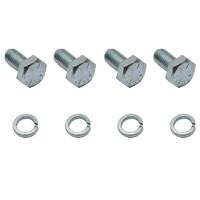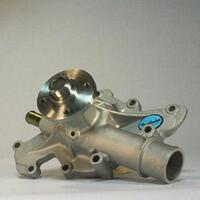FlowKooler High Performance Water Pump 352 390 400 406 427 Ford Big Block FE Series Cast Iron - Generator
SKU code: FK-1642-EARLY
Make 4 interest-free payments of $105.00 fortnightly and receive your order now.
Is your 1961-1964 big block Ford running hot? Flowkooler designed a high flow water pump with a CNC machined billet impeller to increased vane count and a reduced casting-to-impeller vane clearance. It achieves greater flow rates, higher head pressure and a more efficient flow. The impeller color is due to Type II Class II military grade surface coating which protects against corrosive fluids.
FlowKooler introduced the first hi flow pumps and continues to improve impeller design. Why is increased flow so important to cooling a hot Ford FE engine? Because it has been proven time and time again that reducing the cycle time between the heat source and the heat sink creates more opportunities to shed heat and drop engine temperatures.
Prior to 1965 Ford FE motors utilized a generator. In 1965 Ford switched to an alternator. Please note the 1642E pump has a dowel pin to accommodate the generator bracket. Additionally the "flat part" of the casting near the hose connection is a greater area which allows for the larger pulley.
From 0-3,300 RPM…Nothing Beats a FlowKooler!
|
|||||||||||||||||||||||||||||||||||||||||||||
|---|---|---|---|---|---|---|---|---|---|---|---|---|---|---|---|---|---|---|---|---|---|---|---|---|---|---|---|---|---|---|---|---|---|---|---|---|---|---|---|---|---|---|---|---|---|
| Make | Model | Year | Block | CID | Liters |
|---|---|---|---|---|---|
| ford | custom 500 | 1964 | V8 | 390 | 6.4L |
| ford | custom 500 | 64-61 | V8 | 352 | 5.8L |
| ford | custom 500 | 64-64 | V8 | 406 | 6.6L |
| ford | custom 500 | 64-64 | V8 | 427 | 7.0L |
| ford | fairlane | 1964 | V8 | 427 | 7.0L |
| ford | fairlane | 64-62 | V8 | 390 | 6.4L |
| ford | galaxie, galaxie 500 | 63-62 | V8 | 400 | 6.6L |
| ford | galaxie, galaxie 500 | 64-61 | V8 | 352 | 5.8L |
| ford | galaxie, galaxie 500 | 64-61 | V8 | 390 | 6.4L |
| ford | galaxie, galaxie 500 | 64-61 | V8 | 406 | 6.7L |
| ford | galaxie, galaxie 500 | 64-61 | V8 | 427 | 7.0L |
| ford | ltd | 1965 | V8 | 352 | 5.8L |
| ford | ltd | 1965 | V8 | 390 | 6.4L |
| ford | ltd crown victoria | 1965 | V8 | 352 | 5.8L |
| ford | thunderbird | 1963 | V8 | 427 | 7.0L |
| ford | thunderbird | 61-64 | V8 | 390 | 6.4L |
Who uses a Hi Flow Water Pump?
Whether it is in stop and go traffic, a slow moving parade, in line at a car show, off road on the trails or hauling a heavy load up a grade all cars face reduced airflow through the radiator at slower speeds. We have sold pumps to muscle car owners, street rodders, off road rock crawlers, people towing RVs and horse trailers, boat owners and even Propane powered trucks!
The Benefits of Hi Flow Water Pumps
1. Lower Engine Temperatures.
Most engines keep cool at highway speed. It makes sense; the engine is turning the fan at with higher rpm and the water pump is spinning rapidly and sending coolant through the radiator. The radiator has good airflow at highway speed. Of course engines stay cooler. However, at low speed, it is a different story; engines tend to heat up when you face limited airflow, trapped airflow and slower moving coolant. These condition exist in stop-and-go traffic, at car shows, rock crawling or off-road or in any vehicle under a load. FlowKooler has focused on increasing the flow rates at lower rpms to resolve low speed overheating. At idle our pumps pump more than twice other pumps and we outflow “performance” pumps by 20%. FlowKooler pumps take the coolant out of the engine and put it in the heat exchanger or radiator to keep your cool.
2.Eliminate Hot Spots and Steam Pockets
Engine blocks machined with limited or no cooling jacket can result in steam pockets and hot spots. This design is great for getting more bore out of your engine but notorious for overheating. At idle the creation of a hot spot at the top of the cylinder may be enough to cause pre-ignition. At the extreme steam pockets can lead to detonation (hot spots in the cylinder wall); detonation leads to broken parts. At high rpm the coolant moves through the block fast enough to prevent any steam pockets from forming. FlowKooler pumps suppress engine hot spots and steam pockets by sending more coolant through the system at low speed and simultaneously raise engine block pressure 22% to prevent their formation.
3. Ending Early Cavitation
Cavitation is the formation of vapor bubbles in a flowing liquid where the pressure of the liquid falls below its vapor pressure. When the vapor bubble that forms rapidly collapses it produces a destructive shock wave that damages the interior wall of the engine block and other components, causes vibrations and noise and results in a loss of flow efficiency. FlowKooler impellers tighten clearances to reduce "slop" in the casting chamber and build pressure. This helps to prevent the onset of cavitation.
4. Stop the Knock
Knock, detonation or ping…call it what you want - it is a problem. Ping heard when the engine is shut off may be the result of pre-ignition. Pre-ignition results from the air/fuel mixture igniting in the cylinder before the spark plug fires from an ignition source other than the spark. Hot spots can damage to the point they actual burn holes right through the top of pistons. Causes include:
- Carbon deposits form a heat barrier
- An overheated spark plug
- A sharp edge in the combustion chamber or on top of a piston
- A sharp edges on valves
- A lean fuel mixture
- Low coolant level
- Slipping fan clutch
- Failed electric cooling fan
Flowkooler hi flow pumps help reduce engine temperatures and stop the after run or pinging characteristic of a pre-ignition condition. Knock can also occur when the combustion of in the cylinder starts off correctly with spark plug ignition but one or more pockets of air/fuel mixture explode outside the envelope of the normal combustion front ignition. It will cause the peak of the combustion process to occur outside of the optimum moment and results in a characteristic metallic "pinging" sound. The other consequence is an increases in cylinder pressure which can be harmless or destructive to rings piston or bearings.
5. Gain Horsepower
A poorly designed water pump casting and impeller can result in wasted horsepower. FlowKooler pumps are designed to move water more efficiently from the radiator to the block to keep you cool. Some refer to the improvement in flow efficiency as a gain in horsepower, other call it a conservation of horsepower. Whatever you call it, FlowKooler pumps are 32% more efficient than OEMs which means less horsepower is used to turn them.
Hold on...doesn't the coolant have to have more time in the radiator to cool?
No. But a lot of people still think so. We have come up with some explanations for the Doubting Thomas.
Debunking the I Can Have It Both Ways Theory
The water has to have time to cool argument is most common one we hear. In a closed loop system if you keep the fluid in the heat exchanger you are simultaneously keeping it in the block longer. Unfortunately, the block is the part that is generating the heat. Sending hot coolant from your source (engine) through the heat exchanger (radiator) to the sink (air) will transfer heat as long as there is a temperature difference between the source and sink. The engine is still generating heat the whole time so why keep the coolant there any longer than you have to.
Debunking The Conscientious Electron Theory
We hear that the coolant has to stay in the system longer to cool but what is heat transfer really but conduction, convection and radiation of electrons. The fluid in your system transfers those electrons based principally on the source-sink differential and the exchange material's transfer rate. An electron moves at varying speeds - Bohr's model has it moving at 2 million meter/second. But let's just agree it is fast (really really fast). Far faster than the flow rate of the water pump. Your engine coolant's electrons do not know (or care) how fast you send then through the system - they just knows that the source is hotter than the sink and off they go.
Debunking Grandpa's Flathead Theory
"But wait a minute, I know Grandpa' used to put washers in his flathead to slow the flow and cool his engine." We know people did this too. They still do it but the cooling benefit is not from the slower flow but the pressure that builds from the restriction. Consider that Grandpa had two flathead water pumps sending twice the volume through the same size radiator core. Ask him and he might tell you his overheating woes were really as he tore up the track at high speed. Grandpa caused cavitation in his pump by with higher rpm and unrestricted flow and the result was overheating due to cavitation.
Restricting his flow with a washer build up his pump pressure and pressure in the block helped reduce the onset of hot spots on his cylinder walls and formation of steam pockets. So Grandpa was on to something but just not for the reason most people think. This restrictions makes sense when your rpm is excessive but it rarely makes sense normal driving conditions.
If you doubt this thinking then try this simple Ask Dr. Science experiment where you restrict the pump on the suction side; just clamp off the lower hose while you watch your temp gauge. Hopefully, you will debunk Grandpa's theory yourself before you experience vapor lock.
Restriction is not all bad if it serves to prevent cavitation. Cavitation occurs when a pump turns so fast that you generate lower pressure and air bubbles or vapor forms. These bubbles eventually implode and damage the engine block wall and impeller. Rapidly spinning the impeller can literally rip the air from water but may not actually move the fluid, it's tantamount to turning an eggbeater in a paint bucket. Restricting the fluid flow to raise system pressure in the block may help prevent cavitation at higher RPM but is it necessary for most vehicles?
No. Most vehicles do not need to restrict flow because they do not reach or sustain high RPM. Additionally, thin aluminum radiators already restrict by design e.g. fewer rows of tubes. Restrict it further and you may as well hose clamp the lower radiator hose and we know how that works out. When you face Grandpa on the track you may want your washers, otherwise, keep them in the toolkit.
Simply put, you have a far better chance of keeping your cool with a greater flow rate through your heat exchanger than gathering heat in your engine block.
- 352 390 400 406 427 Ford Big Block FE Series
| SKU | FK-1642-EARLY |
| Brand | FlowKooler |
| Shipping Weight | 7.5000kg |
| Shipping Width | 0.040m |
| Shipping Height | 0.020m |
| Shipping Length | 0.250m |
Be The First To Review This Product!
Help other Custom Mustangs users shop smarter by writing reviews for products you have purchased.

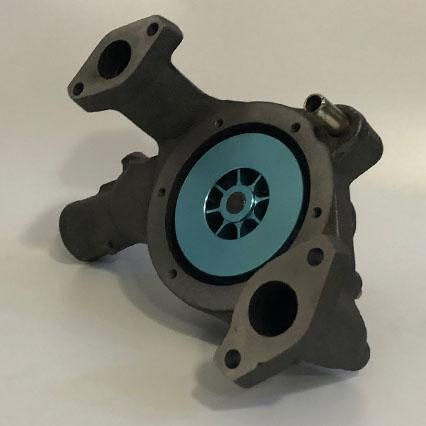
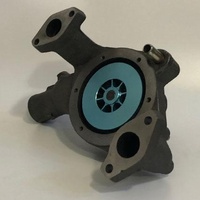


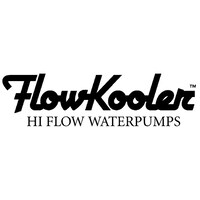
 More info
More info